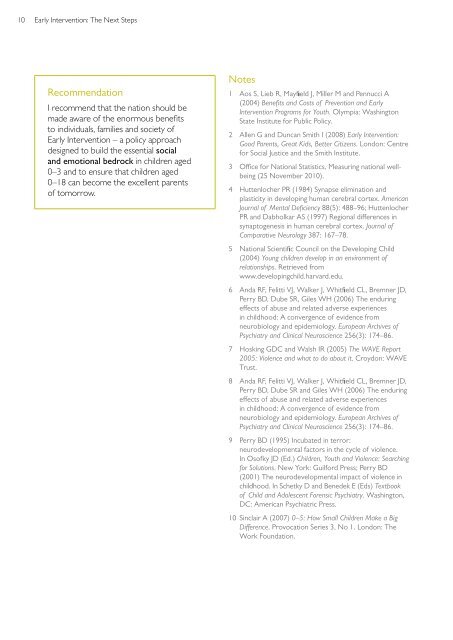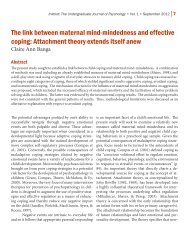early-intervention-next-steps
early-intervention-next-steps
early-intervention-next-steps
You also want an ePaper? Increase the reach of your titles
YUMPU automatically turns print PDFs into web optimized ePapers that Google loves.
10 Early Intervention: The Next Steps<br />
Recommendation<br />
I recommend that the nation should be<br />
made aware of the enormous benefts<br />
to individuals, families and society of<br />
Early Intervention – a policy approach<br />
designed to build the essential social<br />
and emotional bedrock in children aged<br />
0–3 and to ensure that children aged<br />
0–18 can become the excellent parents<br />
of tomorrow.<br />
Notes<br />
1 � Aos S, Lieb R, Mayfeld J, Miller M and Pennucci A<br />
(2004) Benefts and Costs of Prevention and Early<br />
Intervention Programs for Youth. Olympia: Washington<br />
State Institute for Public Policy.<br />
2 � Allen G and Duncan Smith I (2008) Early Intervention:<br />
Good Parents, Great Kids, Better Citizens. London: Centre<br />
for Social Justice and the Smith Institute.<br />
3 � Ofce for National Statistics, Measuring national wellbeing<br />
(25 November 2010).<br />
4 � Huttenlocher PR (1984) Synapse elimination and<br />
plasticity in developing human cerebral cortex. American<br />
Journal of Mental Defciency 88(5): 488–96; Huttenlocher<br />
PR and Dabholkar AS (1997) Regional diferences in<br />
synaptogenesis in human cerebral cortex. Journal of<br />
Comparative Neurology 387: 167–78.<br />
5 � National Scientifc Council on the Developing Child<br />
(2004) Young children develop in an environment of<br />
relationships. Retrieved from<br />
www.developingchild.harvard.edu.<br />
6 � Anda RF, Felitti VJ, Walker J, Whitfeld CL, Bremner JD,<br />
Perry BD, Dube SR, Giles WH (2006) The enduring<br />
efects of abuse and related adverse experiences<br />
in childhood: A convergence of evidence from<br />
neurobiology and epidemiology. European Archives of<br />
Psychiatry and Clinical Neuroscience 256(3): 174–86.<br />
7 � Hosking GDC and Walsh IR (2005) The WAVE Report<br />
2005: Violence and what to do about it. Croydon: WAVE<br />
Trust.<br />
8 � Anda RF, Felitti VJ, Walker J, Whitfeld CL, Bremner JD,<br />
Perry BD, Dube SR and Giles WH (2006) The enduring<br />
efects of abuse and related adverse experiences<br />
in childhood: A convergence of evidence from<br />
neurobiology and epidemiology. European Archives of<br />
Psychiatry and Clinical Neuroscience 256(3): 174–86.<br />
9 � Perry BD (1995) Incubated in terror:<br />
neurodevelopmental factors in the cycle of violence.<br />
In Osofky JD (Ed.) Children, Youth and Violence: Searching<br />
for Solutions. New York: Guilford Press; Perry BD<br />
(2001) The neurodevelopmental impact of violence in<br />
childhood. In Schetky D and Benedek E (Eds) Textbook<br />
of Child and Adolescent Forensic Psychiatry. Washington,<br />
DC: American Psychiatric Press.<br />
10 Sinclair A (2007) 0–5: How Small Children Make a Big<br />
Diference. Provocation Series 3, No 1. London: The<br />
Work Foundation.



